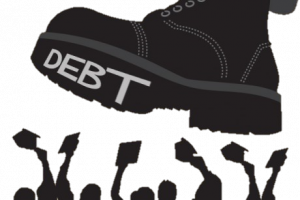There are several reasons why someone may need to take out a loan. Buying a home, buying a car, emergencies, medical expenses all cost lots of money, money that most people do not have laying around in their bank account. One of the first experiences many people have with borrowing money, is taking student loans. Once an individual has decided to pursue a college education they have to acknowledge the costs that come along with it. There are many ways students pay for college because each student’s financial situation is different. Some people have a fund saved up and are prepared to pay their schooling straight forward, some have received scholarships, and others maybe need financial aid. There are a few different forms of financial aid, student loans being one of them. There is nothing wrong with student loans as long as they can be managed properly.
WHAT ARE STUDENT LOANS?
If you apply for financial aid, you may be offered loans as part of your school’s financial aid offer. A loan is money you borrow and must pay back with interest (Federal Student Aid). Before accepting any form of loans, the terms must be carefully read through and fully understood. Usually a short online financial counseling session is required before you can even receive the loan. There are a few different types of student loans available. Direct subsidized/unsubsidized loans are offered to undergraduates who may or may not need financial assistance to help cover the cost of their education. Direct PLUS loans are for graduates or professional students and parents to help cover educational expenses. Direct consolidation loans merge all eligible federal student loans into one loan. The amount of money borrowed in student loans varies from around $5,000 to $20,000 a year depending on whether the person is an undergraduate or already graduated. One of the biggest reasons people get student loans opposed to private loans is because the interest rate is very low and the loans do not need to start being paid off until after the person leaves school. There are many perks to getting a student loan, and they are so very helpful for the average struggling college student.
MANAGING STUDENT LOANS.
After getting student loans, it is important to establish a plan on paying the loan back in the future. Obviously a person cannot see into the future and decipher whether they get a well-paying job or not, but one needs to keep in mind once they are done with school the loans, no matter how many are taken out, have to be paid back. This can prevent a person from taking out more than they know they can afford to pay back, along with frivolous or unnecessary spending. Seven in 10 seniors (69%) who graduated from public and nonprofit colleges in 2013 had student loan debt, with an average of $28,400 per borrower (Institute for College Access & Success). Keep in touch with the loan lender, keep addresses up to date, know grace periods, and look into options for loan repayment and forgiveness. All of these things are key in being responsible for loans and keep people out of trouble. People that are having to use student loans should learn to live frugally. Remember, just because loans are there for support doesn't mean people can just not work through college. Stay on top of things and just take the payments as they come. Even though there is a lot of money being dealt with, try to keep it together and do not panic. Tons of student have to deal with loans from college, it is just a part of life some people cannot avoid. Student loans are only bad if one lets them get to that point.
PAYING BACK STUDENT LOANS.
When you make a federal student loan payment, it covers any late fees first, then interest, and finally the principal (Institute for College Access & Success). When it is time to pay back loans, do not put it off! If the money is not paid back it can lead to delinquency and default, which means the entire amount of loans is jacked up and must be paid in full. It can be paid off in time with the lowest payments possible. If a person can afford it, a great way to save money in the long run is to pay more than the minimum monthly payment. This will help pay the loan faster and reduce some of the cost spent on interest. Also, if dealing with more than one loan it is best to pay off the most expensive one first or the one with the highest interest. Loan forgiveness is a program that sometimes pays any remaining debt after a number of years depending on the field the student is now working in.
STUDENT DEBT STATISTICS.
$1.1 trillion: The amount of outstanding student loan debt, which first exceeded $1 trillion in March 2012.
37 million: The number of Americans who have student loan debt.
2: The ranking of student loan debt compared to other types of consumer debt, second only to mortgages.
$101.8 billion: The Department of Education’s estimated profits generated from student borrowers over the last five fiscal years.
Nearly 300 percent: The amount student loan debt has grown over the past eight years.
$26,600: The amount the average college graduate (of the class of 2011) owed in college loans.
40 percent: The share of households headed by someone under 35 that owed college debt in 2010.
More than 80 percent: The percentage of bankruptcy attorneys who reported that the number of their clients with student loan debt increased “significantly” or “somewhat” in a February 2012 survey.
Nearly 1 in 5: The number of households that had student loan debt in 2010 – double the share of households burdened by college debt in 1989!
6.8 percent: The new interest rate on subsidized student loans starting July 1 if Congress does nothing. The new interest rate would be double the current interest rate.
More than 1 in 10: The number of borrowers that defaulted on their student loans in the three years leading up to Sept. 30, 2011.
22.7 percent: The default rate in the three years leading up to Sept. 30, 2011 for borrowers that attended for-profit colleges, compared to a default rate of 11 percent for borrowers that attended public colleges. (Shocking Student Debt Statistics)
Loans can give students an advantage or they can drag students into a stressful ongoing debt. Debt does not need to be a burden carries around for years after graduates finish school. There are both positive and negative outcomes of student loans, the student has to decide what they are going to choose.
 Relationship Advice
Relationship Advice


 jldonner
jldonner